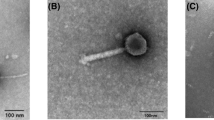Summary
The present researches have been made with thePhagus lacticola (P. and O.) induced on the acid-fastMycobacterium battaglini. This is an excellent material for the study of the mycobacteriophage system because once infected with the phage it becomes transparent to electrons.Phagus lacticola, as other phages, comprises a head and a tail, both covered by a unique membrane. Inside it is possible to see a certain number of small granules, which, after the phage has been absorbed by the germ, penetrate the cell, leaving outside only an empty membrane. Once inside the cell the granules multiply, giving a moruliform body which later resembles a corn-cob. The round elements of this formation show a very small central vacuole. In time this vacuole enlarges and these elements become larger and detached, assuming an annular shape (doughnuts). Once detached, they multiply in two or four and form a rosette. The single elements detach from the rosette; each one assumes a short flagellum, which then elongates, while the annular element swells and assumes the form of a mature phage, which is freed by rupture of the cell. The phages therefore have a complex cycle of development inside the host: the various phases we have been able to see are in accordance with the cycle of other living organisms and are shown here by a series of electron micrographs.
Similar content being viewed by others
Literature
Anderson, T. F., 1949: The reaction of bacterial virus with their host cells. Bot. Rev.15, 464.
—, 1952: Stereoscopic studies of cells and viruses in the electron microscope. Amer. Naturalist86, 91.
—, C. Rappaport, and N. A. Muscatine, 1953: On the structure and osmotic properties of phage particles. Ann. Inst. Pasteur, Par.84, 5.
De Mars, R. J., S. E. Luria, H. Fisher, and C. Levinthal, 1953: The production of incomplete bacteriophage particles by the action of proflavine and the properties of the incomplete particles. Ann. Inst. Pasteur, Par.84, 113.
Evans, E. A. jr., 1953: The origin of the components of the bacteriophage particles. Ann. Inst. Pasteur, Par.84, 129.
Hershey, A. D., 1953: Intracellular phases in the reproductive cycle of bacteriophage T2. Ann. Inst. Pasteur, Par.84, 99.
—, C. Roesel, M. Chase, and S. Forman, 1951: Carnegie Inst., Washington Yr. Bk.50, 195.
Hillier, J., 1950: Electron microscopy of microorganisms and viruses. Ann. Rev. Microb.4, 1.
Levinthal, C., and H. Fisher, 1952: The structural development of a bacterial virus. Biochem. a. Biophys. Acta9, 419.
Lwoff, A., 1953: L'induction. Ann. Inst. Pasteur, Par.84, 225.
— and A. Gutmann, 1950: Recherches sur unBacillus megatherium lysogène. Ann. Inst. Pasteur, Par.78, 711.
Maalöe, C., and J. D. Watson, 1951: The transfer of radioactive phosphorus from parental progeny phage. Proc. Nat. Acad. Sci.37, 507.
Putnam, F. W., and L. Kozloff, 1950: The fate of infecting virus particle. J. biol. Chem. (Am.)182, 243.
Author information
Authors and Affiliations
Rights and permissions
About this article
Cite this article
Penso, G. Cycle of phage development within the bacterial cell. Protoplasma 45, 251–263 (1955). https://doi.org/10.1007/BF01253412
Received:
Issue Date:
DOI: https://doi.org/10.1007/BF01253412




